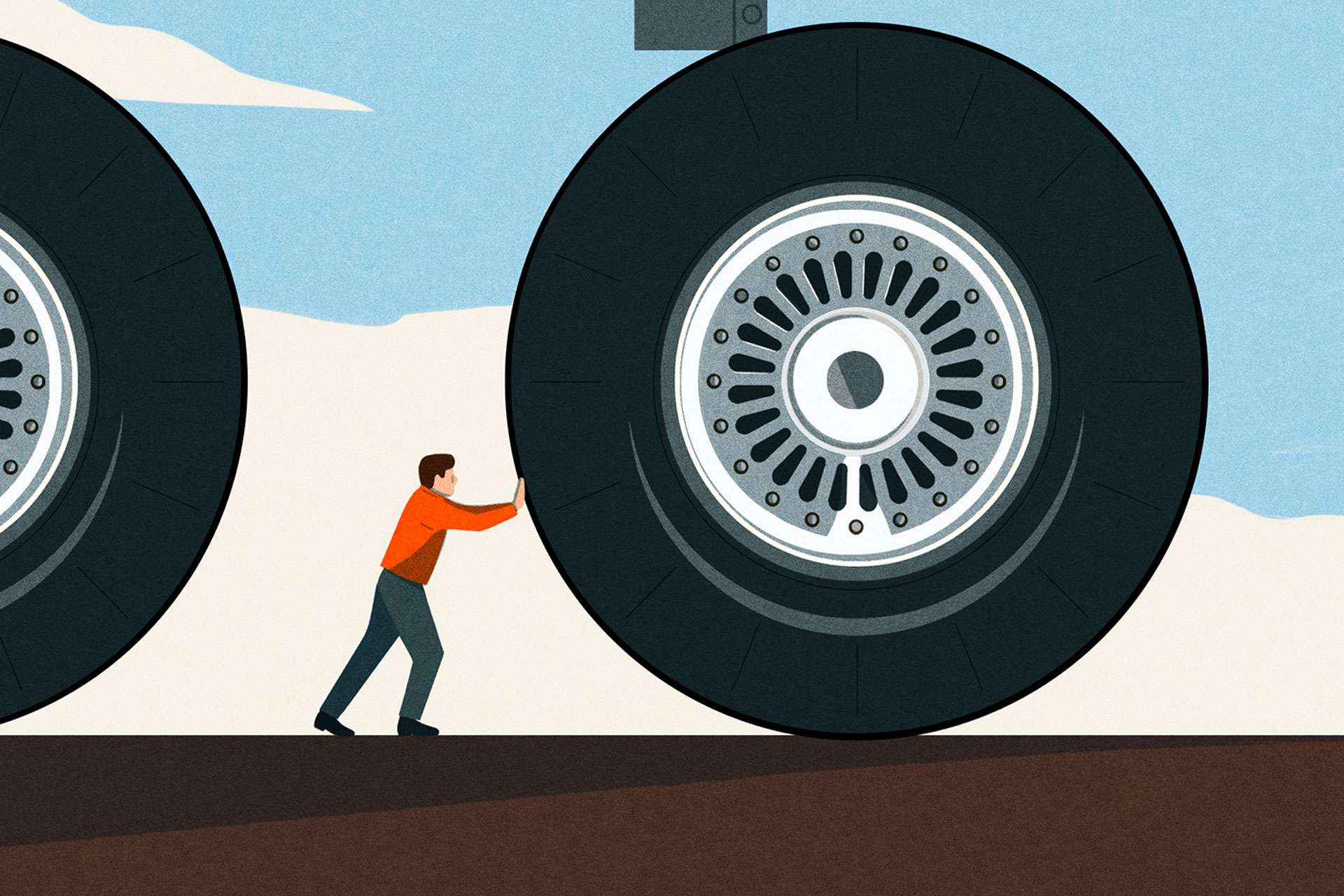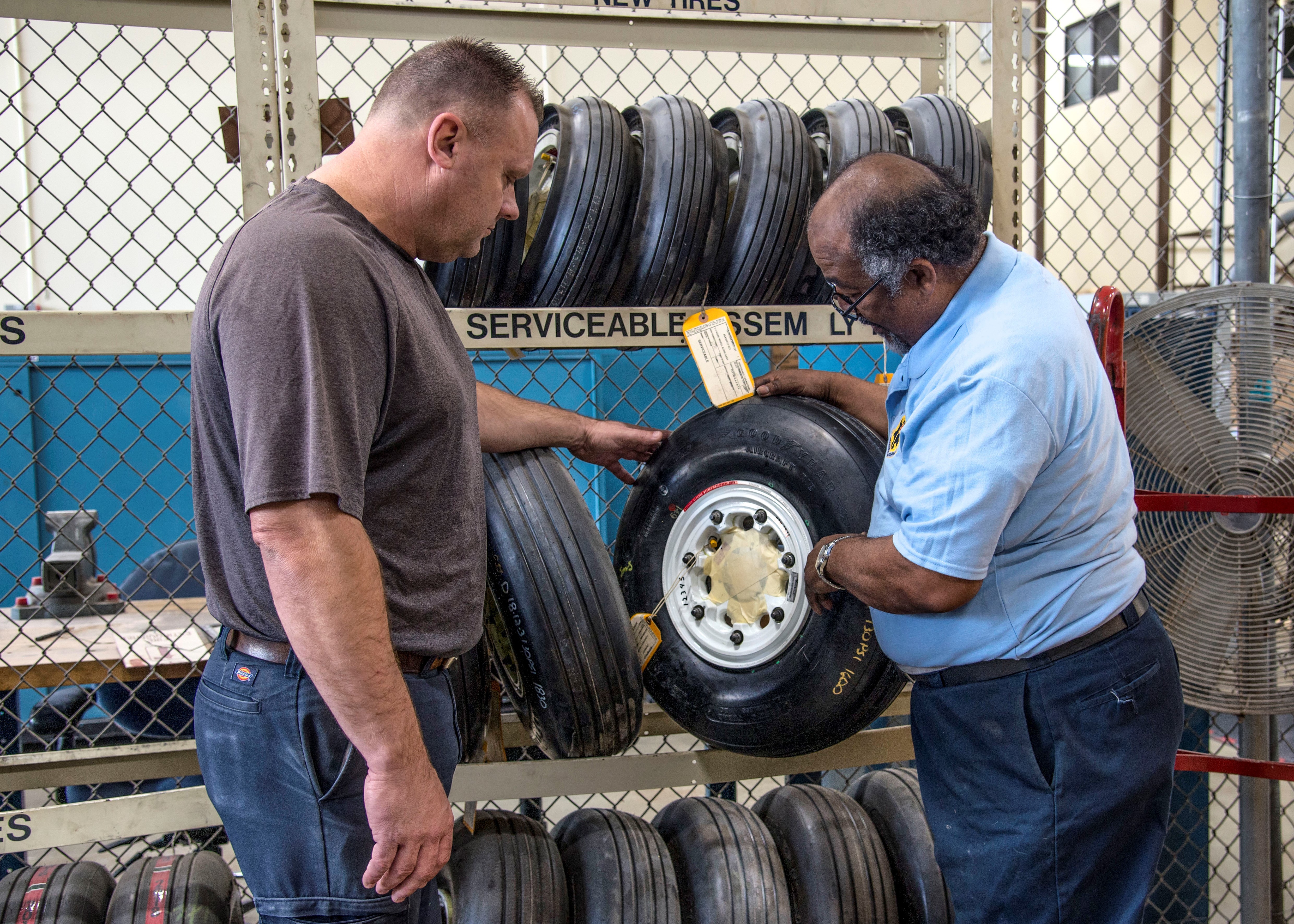Aircraft Tire Servicing - Most of us tend to pay very little attention to tires and some people are tempted to think of them as the ones on our cars. We "shadow tree mechanics" are especially vulnerable because we can consider ourselves experts. But nothing could be further from the truth.
Aircraft tires are subject to greater temperature changes, have higher pressures, and have tighter tolerances for what is acceptable and unacceptable. You probably know that. But here's the thing: Airplane tires are subject to huge fluctuations in the loads they're supposed to carry, and the resulting amount of sidewall flex can cause damage inside the tire that you can't see from the outside, and can lead to disaster. Tire blowout during takeoff and landing.
Aircraft Tire Servicing

Much of what follows comes from Gulfstream, but I think the lessons and conclusions can be extrapolated to any large airline. Of course, you should consult your aircraft and tire manufacturer's manuals.
Jal And Bridgestone Team Up On Predictive Aircraft Tire Maintenance
You'd think that most manufacturers' instructions (aircraft and tires) have been filtered by lawyers who say you should check your tires daily and that pressure tolerances are too tight. In some cases this may be true. You will need to comb through the instructions provided for your flight. I did this for the Gulfstream G450 to give you an idea of the process of getting your own answers.
The following excerpt is from the G450 maintenance manual, but the techniques are universal. Following are the tire maintenance procedures, i.e. adding nitrogen. However, the procedures for checking tire pressure apply.
"Low pressure" means more than you want in the tire. We usually shoot it at 300 to 400 psi. Dry nitrogen is important because water does not want to condense inside the tire. But more importantly it should be nitrogen and not air. Air contains 78% nitrogen, 21% oxygen and 1% other substances. Oxygen is what you need to worry about when using ambient air in your tires. Air is more sensitive to temperature changes and the normal heating caused by taxiing, takeoff and landing causes the air pressure to increase to a greater extent than pure nitrogen. Air is also more flammable and the rubber is more likely to "bleed".
Most aircraft wheels have a "split rim" design. A normal rim is made in one piece and the tire must be stretched over the rim. While this is practically impossible to do with most tires, rims come in parts, so the tire can be installed in one part and then the second part is attached to the first part. What holds it all together? The rim itself has opposing parts, but the axle is also responsible for holding the two parts together. (This is why you should never remove a wheel from an axle without reducing the pressure.) If any of these things fail, the wheel will fall off. It is responsible for many deaths in the heavy truck industry each year. Airplane wheels have the same danger.
Aircraft Tire Servicing Cart
You need to make sure the tire inflation assembly is lined up with the valve stem and be sure to push everything together to prevent loss of pressure.
Again, you must be firm when removing the inflation assembly to prevent nitrogen leakage.
The cap not only serves as protection against a slightly loose valve, but also prevents foreign dirt from penetrating the valve.
When you check tire pressure with a gauge, you have to bleed a small amount of air/nitrogen to get the reading, which always costs you a PSI or two. There are additional tire stems that allow the electronic reader to do that without losing pressure.
Tire Inflation Cage
For example, Crane Aerospace's "SmartStem" system replaces your existing stem and includes an electronic pressure gauge. A typical 6-wheel business jet costs more than $6,000. Here's a video of the system in action: SmartStem Tire Pressure System. More information: https://www.craneae.com/Products/Sensing/SmartStemBizJets.aspx.
This depends on the manufacturer of your aircraft. For the Gulfstream G450, we have a chart that correlates our tire pressure with the expected maximum gross weight before the next service.
The Goodyear manual indicates that the minimum pressure is based on the maximum weight of the aircraft, but here the aircraft manufacturer's certification takes precedence.
The manual writers here mean 4% off your goal. For example, if you want 190 psi when the weight of the airplane is on the wheel, you should inflate to 190 - 4% (182 psi) if the weight of the airplane is not on the wheel.
The Impact Of Truck Tire Maintenance On Diesel Fuel Economy Cannot Be Understated
These are the ambient temperature, the temperature around you and the tires. Even after a flight or taxi operation, the temperature of the nitrogen inside the tire must be given time to settle. Dragging the plane for a while is enough to raise the temperature. We usually wait four hours after the flight before servicing the tires.
There are no specific instructions in the G450 maintenance manual about how often to check tire pressure. Pressure testing There is an argument that frequent pressure testing can be a problem because there is usually little loss of nitrogen. I recommend:
Tire pressure affects more than wear, but determines the aircraft's ability to take off, abort or stop after landing. Although it may seem obvious, an under-inflated tire can be the cause of a catastrophic failure leading to the loss of the aircraft and its passengers, as was the case with Learjet 60, N999LJ.

If you fly under 14 CFR 91, you can check the tire pressure. To do this, you must train your mechanic for this task and equip the aircraft with a properly calibrated gauge. Only after we got used to doing this did we realize that checking the tire pressure without a nitrogen bottle is silly. So we monitor our tire pressure loss patterns and have a mechanic give us a fly check at least once a week, including checking the tire pressure.
Aircraft Tyre Maintenance
After the tires went through at least one thermal cycle (taxi, takeoff, landing), we found our tires never dropped less than ½ psi per week. But every time we change the tires, we rebuild the wheels. During the rebuild, the wheel is completely disassembled, cleaned, painted and rebuilt. This ensures we have the best seal possible. If you use unassembled wheels, your pressure drop will be higher. If you have smaller tires, the pressure loss will be higher. A local Falcon 2000 operator told me they expect to lose 2 psi per week but occasionally see 5 psi per week. The G150 operator told me they see 2 dogs in a three day trip.
The previously cited case study of the Learjet 60, N999LJ provides ample evidence of just how dangerous under-inflated tires can be. This plane's manual calls for a tire change if the pressure drops below 15%. Typically, under-inflating a tire by 20% can result in tire failure after three take-offs.
Transferring old guides from a new or different aircraft to your current aircraft may cause you problems. I have flown a plane that allowed the tire cord to wear out. In fact, some have allowed some cords to be exposed. My current airplane needs tire replacement if any tread is worn down to the base. There are also rules regarding haircuts. You should consult your manuals when assessing whether or not a tire needs to be replaced.
Gulfstream hosted a breakfast every Wednesday to cover the latest land issues in Savannah. The information was so good that they started publishing better topics in something called "Morning Minutes". Here are some notes on the importance of properly inflated tires.
Wheel And Tire Shop Keeps Mission Rolling > U.s. Air Forces Central > Article Display
Following are nine steps to proper inflation procedures. (When servicing the assembly, always use a cylinder or supply line with a pressure regulator that should be 50 percent higher than the tire's nominal pressure. Overinflation from an unregulated pressure supply can cause a wheel or tire to burst, causing injury or death. . . )
The Goodyear Aircraft Tire Care and Maintenance Manual is very good, but covers a wide variety of tires. You also need to check your aircraft manufacturer's manuals.
Regular inspection of installed tires is strongly recommended for tire safety and economy. The frequency of inspection should be determined by the use and normal tire wear of the aircraft concerned. Some aircraft require a tire check after each landing or turn. A thorough inspection is recommended for all aircraft after a hard landing.
Visually inspect the tread and check the rest of the tread. Tires must be removed when the tread is worn to the base of any groove or minimum depth at any point as specified in the aircraft manual.
Michelin And The Faa Offer An Updated Course On Aircraft Tire Maintenance :: Michelin North America, Inc
In order
Aircraft servicing equipment, aircraft toilet servicing, aircraft tire servicing tools, aircraft tire inflator, aircraft tire bead breaker, aircraft nitrogen servicing cart, aircraft oxygen servicing, aircraft servicing, aircraft tire pressure gauge, aircraft oxygen servicing equipment, aircraft tire gauge, aircraft strut servicing tool



0 Comments